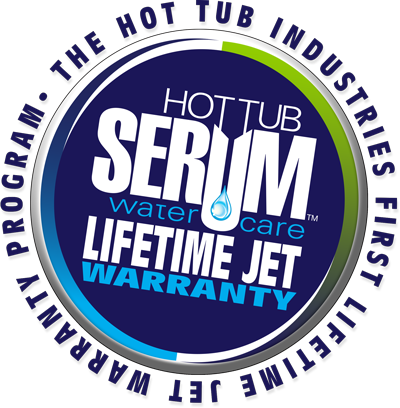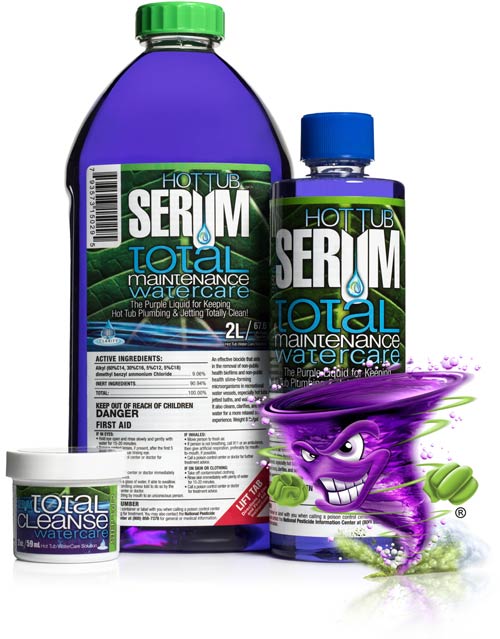Your new hot tub just arrived! You’ve been looking forward to this day for quite some time. Your thought of a relaxing, quiet soak at the end of the day is now just about reality! Or perhaps it some time with your family & friends! Or maybe it’s knowing you now have the spa to relieve the pain of arthritis, fibromyalgia, or other ailments.
However, all of these require clear, safe, warm water in your spa. So right about now you think to yourself, how do I maintain my new spa? Hot Tub Serum should be part of your maintenance plan, but let’s take it step by step.
First Things First
One of the great things about a spa is you can use it any time – Just open the cover and hop in. But I always tell folks that owning a spa, like a pool, requires a discipline. That is to say, “Check your spa water chemistry two or three times a week, at the very least weekly, and make any adjustments needed.” This is true no matter what sanitation system you might be using. Simply put, There are no Maintenance-Free Spa Sanitation Systems!
That said, it is actually quite easy to maintain your spa but a regular check of your spa water and making needed adjustments is required. As the saying says, “An Ounce of Prevention is Worth a Pound of Cure.” It’s true. If you don’t do this, your local spa pros can get your spa back to perfect, but it’s much easier to just keep it that way.
Clear Water
Most folks think their spa is safe to use when the water is clear. There is a fair amount of truth to this because most of the time, and that mean’s 98% of the time, cloudy, murky water is a sure sign of either insufficient sanitizer or ineffective sanitizer. That also means potentially dangerous pathogens, including various bacteria and viruses, may be in your spa water. The bottom line is, don’t use your spa unless the water is crystal clear.
Spa Water Chemistry
However, proper levels of spa sanitizer (usually either chlorine or bromine), pH (the acidity of your water), Alkalinity, and Calcium are also important to ensure your comfort, ease of operation, and preventing any damage to your spa. There are many different testing techniques, but most folks use the plain old dip testers. Put one in between your fingers, put it about 10” below the water line, take it out and match the colors to the various measurements. If needed adjust your spa water to these levels.
| Cl or Br | 1.5 – 3.0 ppm or 3.0 – 5.0 ppm |
| pH | 7.2 – 7.6 |
| Alkalinity | 80 – 120 ppm |
| Calcium (Total Hardness) | 100 – 250 ppm |
A few additional comments:
- If you have a Salt-System Spa great! They are either chlorine or bromine based so the levels noted above are still good.
- If you are using one of the various metal ion-based sanitation systems, they still use either chlorine or bromine, however they typically require lower levels. Check their directions
- Biguanide sanitation is not that common and is a whole different “animal”. Hot Tub SERUM is compatible with these, but you need to read their specific instructions.
Shock Your Spa
Most folks don’t realize this, but you put a lot of contaminants in a small space in a spa. A pool is typically 15,000 – 20,000 gallons while a spa is usually 200 – 500 gallons.
On top of that, you may perspire as much as a pint of sweat in an hour in a spa. This is one of the reasons a hot tub is so beneficial – you release a lot of toxins in your sweat. Its also why you may be thirsty when getting out of your spa.
And one more thing – Those swirling jets in your hot tub scrub off a lot of dead skin cells – sort of like you own personal exfoliation machine.
All of this waste must be removed from your spa. Three different actions are usually at play in your spa to get this done – all of which are oxidizing, or breaking down, these waste products. Both chlorine and bromine are not only sanitizers, they are also oxidizers. You likely also have an ozonator in your spa. Standard oxygen is O2, while ozone is O3. Ozone is a powerful oxidizer, but it remains in your spa for only short periods of time, so the third action is “shocking”.
Hot tub shock is usually a nonchlorine based shock called potassium monopersulfate. You want to shock your spa weekly with a couple of capfuls of shock. If you are using your hot tub heavily then do this 2 or 3x a week.
Add SERUM Total Maintenance
Add 1 ounce of Total Maintenance per 100 gallons of spa water every week!
Regardless of your spa sanitation method, Serum Total Maintenance should be part of your weekly regimen. It is doing 4 things to make your spa experience the best!
- Your primary sanitizer is working very hard to both sanitize and oxidize. For reasons we discuss in our FAQ’s, it can be ineffective or the concentration too low in your spa. Total Maintenance is a powerful back-up, secondary sanitizer to ensure your spa water is safe and clear.
- It prevents biofilm in your spa plumbing – where you cannot see
- It is a strong pH buffer, helping to keep your pH where it belongs
- It prevents black mold from forming on the underneath side of your spa cover
Remember Your Spa Filters
Your filters are removing particulates and oils in your spa water so remove and clean your spa filter(s) every 2 weeks. By the way, biofilm also grows in your spa filter(s), but Total Maintenance prevents this too!
Maintaining Your Spa Cover
If your spa is in direct sun a good part of the day, you will generally have to replace it every 5 years or so. However, you can certainly help it last the full 5+ years by treating it properly. Use a mild soap to wash it down even month and then apply a spa cover protectant. Your local spa dealer will have this in stock.
Purge, Drain, & Refill Your Spa
Every time your spa sanitation method requires a drain and refill, also purge your spa with SERUM Total Cleanse to ensure your hot tub is back to brand-new condition.
Though you can’t see it, virtually all hot tubs will develop biofilm in the plumbing. Our Total Cleanse is the best spa purge available so be sure to use it!
Maintaining Your Warranty
This is something I find folks often overlook, but you shouldn’t. Your spa came with a manufacturer warranty. Be sure to read it to know your responsibilities and their commitment to you.
Spas are unlike any other appliance you own. They are subject to changes your other appliances are not because they are outdoors, and your use of your spa is constantly affecting water quality. There is a good chance your spa came with a 5-Year equipment warranty (covering parts & labor), a 5-Year plumbing warranty (no leaks), and a 10-year shell warranty (no cracks). Though the latter two are often unused, the 5-Year equipment warranty is quite often exercised by spa owners.
One important aspect of your equipment warranty is your responsibility to maintain proper water chemistry in your spa. It’s not just important for your safety. It’s also important to ensure your warranty is not voided.
Let’s Sum It Up
- Two or three times a week, check your water chemistry and make any required adjustments.
- Weekly
- Add 1 to 2 capfuls of nonchlorine based shock
- Add SERUM Total Maintenance
- Twice a month, check and clean your filter(s)
- Once a month, clean your spa cover
- Purge, Drain, and Refill your spa. The frequency will depend on the sanitation method you chose. It may be as often as every 3 months or as little as annually
- Read your warranty to know your responsibilities and your spa manufacturer’s commitment to your spa enjoyment.
Thanks for reading,
Turbo Tony








